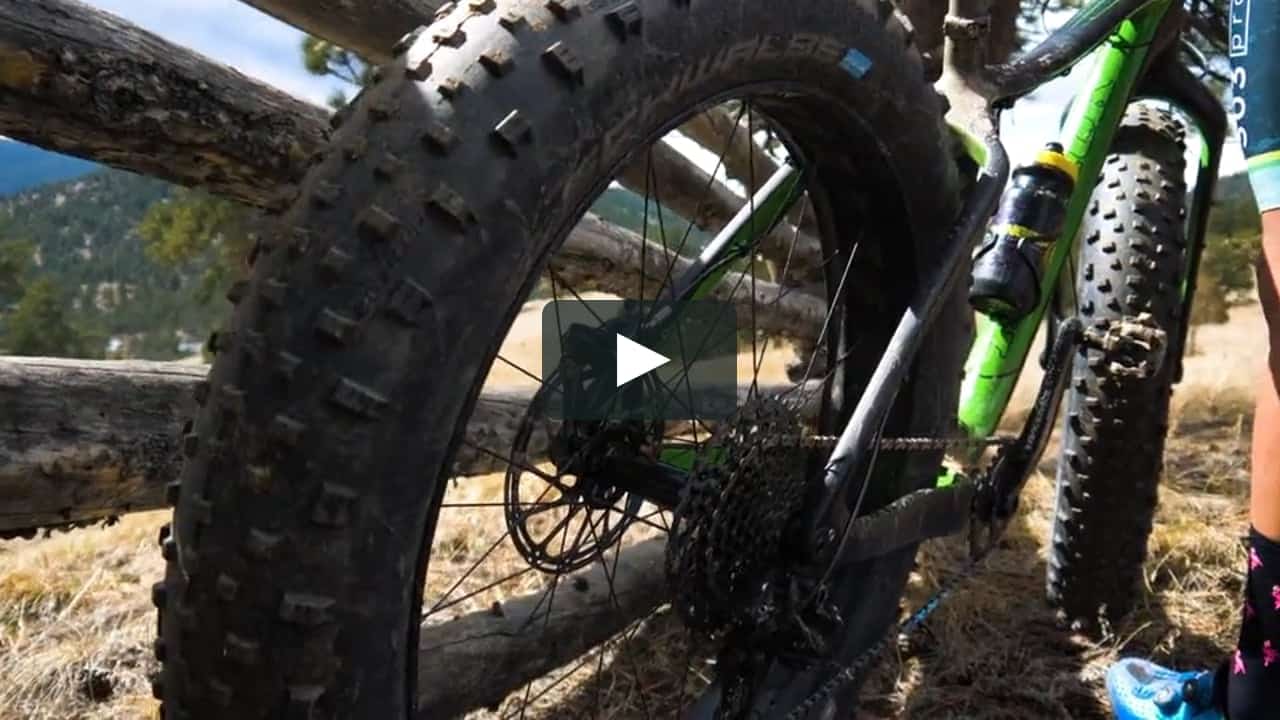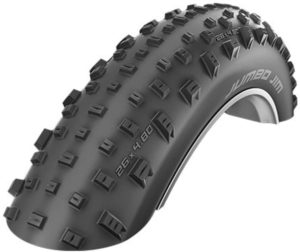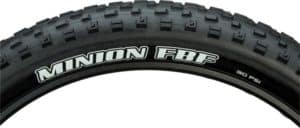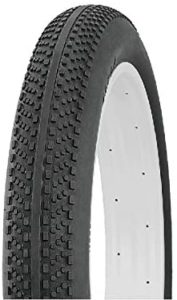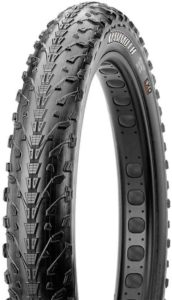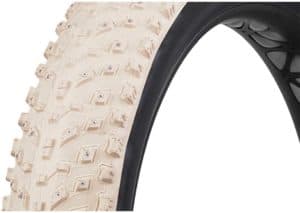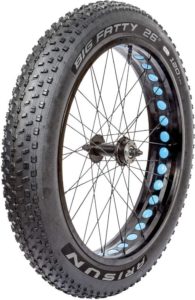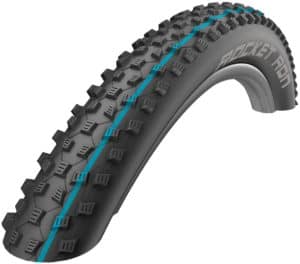I used this list to build the size, quality, weight, and many other features. For each option, Im describing the Pros., Cons., and what makes an option better than the others.
Table of Contents
Comparison Chart
| Fat Bike Tires | Width | Price | More Details |
|---|---|---|---|
| KENDA Juggernaut Pro | 4.0″ | ~$100 | The Review |
| Maxxis Colossus
| 4.8″ | ~$70 | The Review |
| Vee Bulldozer
| 4.8″ | ~$260 | The Review |
| BIG FATTY
| 4.0″ | ~$70 | The Review |
| Schwalbe | 3.0″ | ~$150 | |
| Maxxis Minion | 4.0″ | ~$140 | |
| Origin8 Devist | 4.0″ | ~$80 | |
| SCHWALBE Jumbo | 4.0″ | ~$100 | |
| Fenix | 4.0″ | ~$100 |
Fatbikes are fantastic and offer a good workout, and allow you to try different types of trails like snow or sand.
If you need to upgrade your bike, the tires should be the first to look at, as they are an essential part of a Fatbike.
Lets see their features, pros, and cons.
What is the best Fat Tire Bike?
SCHWALBE Jumbo Jim Evolution TL Easy Folding Tire
This tire is very light, so that it can be used with low pressure.
This makes the tire compatible with areas with deep soil and loose terrain.
The tires have less than 100 millimeters and are easy tubeless versions.
In addition, the SnakeSkin sidewall technology is combined with Schwalbes Pace Star compound.
Some of the features include:
- Tire Bead: Folding
- Tire Diameter: 26″ Fat
- Tire Type: Tubeless Ready Clincher
Best 26×4 fat bike tires
Maxxis Minion FBF Folding Dual Compound Exo/tr Tyre
These tires are one of the innovations in fat bike tires. They offer a specific front tire designed for touring.
The tire features Minion DHF and FBF tread blocks, which make the bike efficient in the turns thanks to low rolling resistance.
When it comes to grip, this tire is the best, even on smooth surfaces.
The bike offers an unparalleled riding experience, even with unpredictable weather conditions.
The tires are always built to give you confidence. The OXO protection makes the tire withstand heavy use in winter or summer.
The advantages of this tire are :
- it is cut and abrasion-resistant, thanks to the material added to its sidewalls.
- The tire is tubeless, which easily increases traction and reduces rolling resistance.
Fenix 26″ x 4.0 Fat Bicycle Tire All Black P-1215
The high-quality black fat bike tire was perfectly created, specifically for the bike with fat 26 by 4.0-inch tires.
The lightweight of the tire makes it ideal for improving speed and reducing drag.
The tire has extensive durability and reliability, making it less prone to punctures.
Other Summer Fat Bike Tires (Also for Winter)
1. KENDA Juggernaut Pro 26×4.00 Tire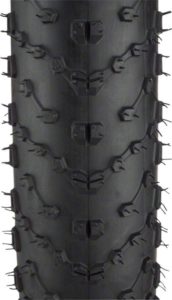
the juggernaut comes in two different sizes
- The 26 inches by 4.0 to the lower profile tread.
- And then the 26 inches 4.50.
The 4.0 model
is best suited for hard snow and fast-rolling conditions.
The entire pattern is based on the never-before-used X tread pattern, which gives a predictable grip.
Brake controls are nice, and the rolling speed is still good.
The 4.5 model
This same pattern is used on the 4.5 model with the taller and larger knobs.
There is much more control on softer terrain like snow, sand, and broken rocks.
There are 3 builds for each of the tires to support votes
- a 60 TPI wire bead
- a sport folding which is a 60 TPI folding bead
- a pro build at 120 TPI folding
2. Maxxis Colossus tire
When it comes to snow, these tires dont seem to do very well in deep snow conditions, no matter what pressure theyre at: They lose their grip, you start sliding around, and they dont do what you want them to do.
But these tires perform well on other types of trails, on ice, gravel, or concrete. Theyre pretty fast, easy to maintain and throw snow well.
So if you want to drive them in the sand and light snow, on groomed trails, and in more superficial conditions, they seem to handle it very well. So theyll exactly do what you want them to do, and theyll be perfect for you.
3. Vee Bulldozer Rubber White
Looking for a fat bike tire thats a little different? Lets take a look at the V bulldozer in white/beige.
Vee has added this distinctive color to their bulldozer line: they offer the bulldozer in this 120 TPI pure silica compound in beige.
The tread on this beige bulldozer is the same as the previous models:
- There are alternating singles and doubles in the center of the tire.
- With side spikes for extra traction.
You can choose from a variety of bulldozer options.
This model is a pure silica compound much softer than their single silica compound.
This tire is a 120 TPI; you can also get bulldozers and 72 TPIs that are a little stiffer.
This model is folded, but it also comes in a metal bead. And they all come in the standard width of 4.8 inches wide.
Placing a caliper on the tire, we see that it is about 4.1 inches (depending on tire pressure), and the tire weight is 1380g.
Note that this 120TPI tire is tubeless-ready and directional.
These tires want to be fast, thanks to the buttons of the central tread being formed to adhere strongly, which is not the case for a tire with a more open tread.
Therefore, youll notice some ground drift when you get into loose conditions and make fast, hard turns.
The pure silica compound these tires are made of makes rock crawling fun. It sticks to the rocks and climbs all day.
When you get into the water, mud, slimy rocks, and roots, these tires slip very little and clean up very well.
This major zoom tire is 4/8 inch:
- so if youre using a 4-inch and looking for a little more float
- Or if youre using a 5″ and want a little narrower to use in the summer. This could be an option.
The PSC compound is super sticky. If you run on pavement, concrete, or other hard surfaces like that most of the time, you might want to look at the NPC version of the bulldozer. The tread compound is a bit tougher.
And if youre looking for a versatile tire that likes to run fast, check out the bulldozer V. It might interest you.
4. BIG FATTY FOLDING FAT TIRE
This Arisun Big Fatty wide wire bead tire is huge. This is the tire that Mongoose put in their Argus Comp 26″ Fat Tire, one of the best bikes on the market.
This huge tire will be the best for riding in sand or muddy areas. It is also perfect for any surface. And this huge wide tire is wrapped around 100mm Xposure rims. So it will give you enough control over your bike.
Its also perfect for a comfortable ride by keeping the right traction for every riders movement.
I reviewed many mongoose bikes, from $300 to $1000. Check out this article: Best Mongoose Fat Tire Bike Models
5. Schwalbe Rocket Ron HS 438
These are great all-around 3″ tires:
- They are very wide, made for comfort, and reinforced with carbon-kevlar for extra protection.
- They work as shock absorbers.
- They have a reflective strip on the sidewall for safety at night.
One small drawback is the pressure range. As printed on the side, these tires pressure range is wide. It goes from 20 psi to 45 psi.
So what would you inflate it to?
That depends on:
- The weight of the rider
- The type of terrain you ride on
- And how much comfort youre willing to give up for performance.
So, the more air in these tires, the faster youll go and the less effort youll have to put into paddling.
But the tires wont absorb bumps as well as they would if they were less inflated.
Also, if you want more grip, you need to deflate it a bit more.
A good starting point would be 35 psi, giving you a good starting point for the rodeo. You can still go fast, and it will also absorb some of the bumps and have a good grip.
6. Origin8 Devist-8er UL Tires, 26 x 4.0, Folding
The tire is ideal for mountain bikes, with directional turns and medium-depth bumps.
The tire is tubeless to reduce rolling resistance.
This folding tire from Origin8 is one of the best for big tires.
Here are some of its features.
- Diameter: 559/26″
- Tire Type: Clincher
- Tire Bead: Folding
Related:
Best Fat Bikes Under 2000 [Speed, Tires, Performance, Power]
Best Budget Fat Bikes Under $1000 – [Top 9 Picks For 2020]
Best Budget Fat Bikes Under 500 [Price, Tires, Design]
Considerations about Fat Tires
Here are some techniques, tips, and bike setups that I think will make you a better fat bike rider. And succeed when youre out on the trail on a fat bike.
Why changing bike tires
When worn out, youll have a flat tire more often when you ride. This is a problem because no one wants to pull over to the side of the road and have to fix a tire, especially in an area with lots of traffic.
Some cyclists try to extend the life of their worn tires by putting a little patch on the tube and simply filling the holes in the tire with superglue to save money.
But this cant last long and can be dangerous sometimes. It is then time to change the tire.
So some indicators let you know when to replace the tire. Check out this article I wrote about When to replace bike tires? TOP 8 Indicators and Safety Tips
How to use Brakes in a Fat Bike
You also need to make sure youre easy on the brakes. The front brakes on MTBs are really powerful. And that can make you slip while riding on a slippery snow trail.
Keeping your weight back will also help you keep the front end light.
Pedaling
Make sure you pedal smoothly or have problems with the rear wheel slipping. Starting up a hill on a slippery trail can be a difficult skill to learn.
It would help if you were smooth. I recommend sitting on the front nose of your saddle to keep the weight on the rear wheel. Then pedaling gently forward will keep the bike in the trails center.
Regarding bike configuration, there are a few things to keep in mind.
Fat Bike Tire Pressure
First, make sure you have the proper tire pressure.
There are 2 general rules to keep in mind when it comes to tire pressure:
- The lower the pressure, the better. And this is especially true in soft snow conditions.
- The wider the tire, the lower the pressure, as it is a higher volume tire, not a higher pressure.
Sometimes fat bike tire pressures can be confusing because they only list a maximum inflation pressure (e.g., 25 psi). But in some tires, the pressure is printed on the side of the bike tire (from 12 to 30 psi).
So, since most bikes with larger tires come with a range already printed on the side of the tire, I wondered how low the fat bike tire pressure could go.
After some testing, I think that 5 to 6 psi is about the lowest you can safely go on a fat bike tire (for some tires, the range is 5 to 30 psi).
However, if you are still using a tire configuration with a tube inside the tire, I would not recommend going that low, as the risk of pinching the tire is higher.
If you want more details about Tire pressure, Check out this article: Fat Bike Tire Pressure and Why it Matters .
.
Fat Bike Tire Treads
Tire treads are another essential factor in preparing your fat bike for a successful ride.
One thing to consider has a tire with good treads gives better results.
Tires with more aggressive tread usually work best in snowy conditions.
But you must make sure you choose the best tire for most conditions you ride in.
Tubeless or not?
Tubeless tires are a huge thing in many areas of cycling right now. A tubeless tire and rim package is a great deal.
Tubeless tires save weight because there is no inner tube underneath. They allow you to use lower tire pressure, which increases.
Tubeless tires save weight because there is no inner tube underneath. They allow you to reduce tire pressure, which increases traction and reduces the chance of a flat.
Choose your flotation
When choosing a fat bike, ask yourself two questions. The first is: how much flotation do you want? There are two groups of fat bikes, those with room for 4-inch tires and those with room for 5-inch or larger tires.
Fat bike saddle height
The seat is also a consideration when setting up your fat bike.
Making it just a little lower than what youre used to will help you keep control in slippery conditions.
Fat bike fork
Another natural question that comes up when it comes to fat bikes is whether or not you should have a rigid suspension fork.
Ive found that riding in the snow with a rigid fork helps keep the front-end light.
And tire pressure, when set correctly, can help dampen the quality of icy trails. So the rigid fork is the best overall.
Fat bike accessories
There are a few other things to consider:
- The first one I recommend is to use non-ratchet shoes. They help keep you warm and protected from the cold. And they help keep the bike under control and be more efficient while climbing.
- And dont forget good quality socks when using your fat bike in icy conditions.
- Bar mittens are also something to have when youre fat biking in the snow: theyre great because they keep your hands warm and allow you to focus on the ride rather than your cold extremities.
- Thermal pants are also a must when fat biking on snowy trails.
